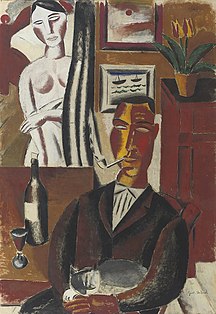Gustave De Smet
- View a machine-translated version of the French article.
- Machine translation, like DeepL or Google Translate, is a useful starting point for translations, but translators must revise errors as necessary and confirm that the translation is accurate, rather than simply copy-pasting machine-translated text into the English Wikipedia.
- Consider adding a topic to this template: there are already 6,211 articles in the main category, and specifying
|topic=will aid in categorization. - Do not translate text that appears unreliable or low-quality. If possible, verify the text with references provided in the foreign-language article.
- You must provide copyright attribution in the edit summary accompanying your translation by providing an interlanguage link to the source of your translation. A model attribution edit summary is
Content in this edit is translated from the existing French Wikipedia article at [[:fr:Gustave de Smet]]; see its history for attribution. - You may also add the template
{{Translated|fr|Gustave de Smet}}to the talk page. - For more guidance, see Wikipedia:Translation.

Gustave Franciscus De Smet (21 January 1877 – 8 October 1943) was a Belgian painter. Together with Constant Permeke and Frits Van den Berghe, he was one of the founders of Flemish Expressionism. His younger brother, Léon De Smet [fr], also became a painter.
Biography
He was born in Ghent. His father, Jules, was a set decorator and photographer. Both Gustave and his brother began working in their father's studio, then attended the Royal Academy of Fine Arts, where they studied under Jean Delvin.[1] Unlike Léon, Gustave was considered to be an indifferent student.
In 1908, he and his wife followed Léon to the artists' colony in Sint-Martens-Latem.[1] There, they initially came under the influence of Luminism and the painter Emile Claus, who lived in nearby Astene. At the beginning of World War I, he and his family joined his friend, Van den Berghe, and fled to the Netherlands. From 1914 to 1922, they moved about, visiting and staying at the art colonies in Amsterdam, Laren and Blaricum.[2] His meeting with the Expressionist painter Henri Le Fauconnier marked a turning point in his style which, up until then, owed much to Cubism.[2]
He returned to Belgium in 1922, but continued to move frequently, usually in the company of his friends Van den Berghe and Permeke, beginning in Ostend, then to Bachte-Maria-Leerne and Afsnee, where he lived in a villa provided by the art promoter and journalist, Paul-Gustave van Hecke. In 1927, he finally settled in Deurle.[1]
It was there that his mixture of Expressionism and Cubism peaked, with a series of works depicting circus, fairground and village scenes. After his death in Deurle at the age of sixty-six, his house was preserved as a local museum.
Selected paintings
-
 The Artist and His Wife
The Artist and His Wife -
 The Great Shooting Gallery
The Great Shooting Gallery -
 The Man with
The Man with
the Bottle - The Young Captain
Public collections
Among the public collections holding works by Gustave De Smet are:
- Antwerp, Royal Museum of Fine Arts Antwerp
- Brussels, Royal Museums of Fine Arts of Belgium
- The Hague, Kunstmuseum Den Haag
- Deinze, Museum van Deinze en de Leiestreek
- Haarlem, Frans Hals Museum[3]
- Ghent, Museum of Fine Arts
- Ostend, Mu.ZEE
- Venlo, Museum van Bommel van Dam
- Zwolle, Museum De Fundatie[4]
References
Further reading
- Piet Boyens, Gust. De Smet. Kroniek – Kunsthistorische analyse, Fonds Mercator, 1989 ISBN 90-615-3194-2
External links

- ArtNet: More works by De Smet.
- Municipal Museum Gustave de Smet, Sint Martens-Latem
















